Can’t stand black spots on hydrangeas? Neither can I! I’m sharing the causes and solutions, plus why I ultimately decided to toss out my own mophead bigleaf hydrangeas!
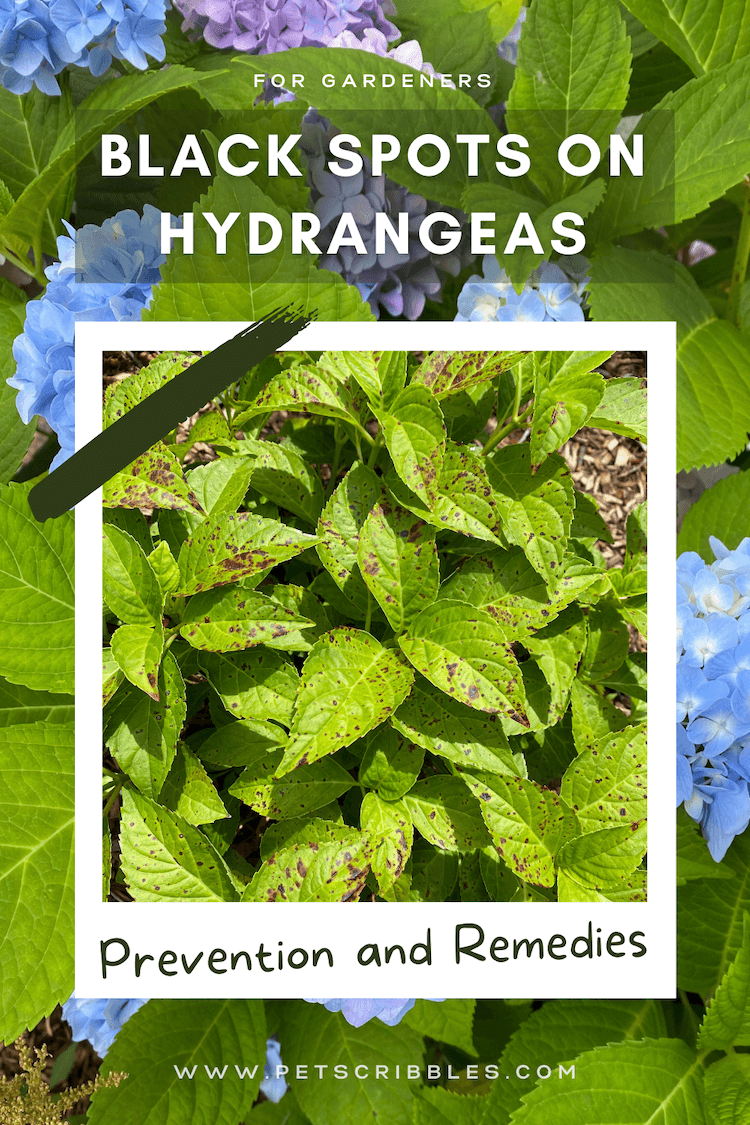
My love of mophead bigleaf hydrangeas!
Ever since I can remember, I’ve adored the deep blue color of hydrangeas that I would see on Cape Cod, Massachusetts and in Newport and Nantucket, Rhode Island.
(I used to live in New England and was lucky to visit those places a lot over the years.)
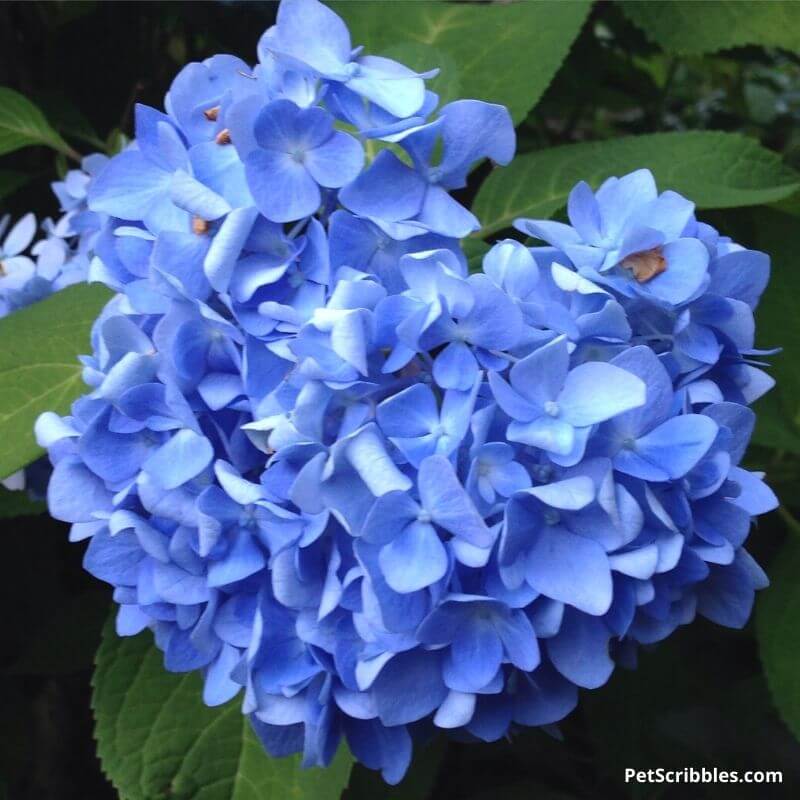
When we moved to our home in southern New Jersey, I planted two Endless Summer hydrangeas which did great for us, mainly because they were planted in a sunny location that also retained a ton of water.
The garden was also in a windy location, so daily good air circulation was built in naturally.
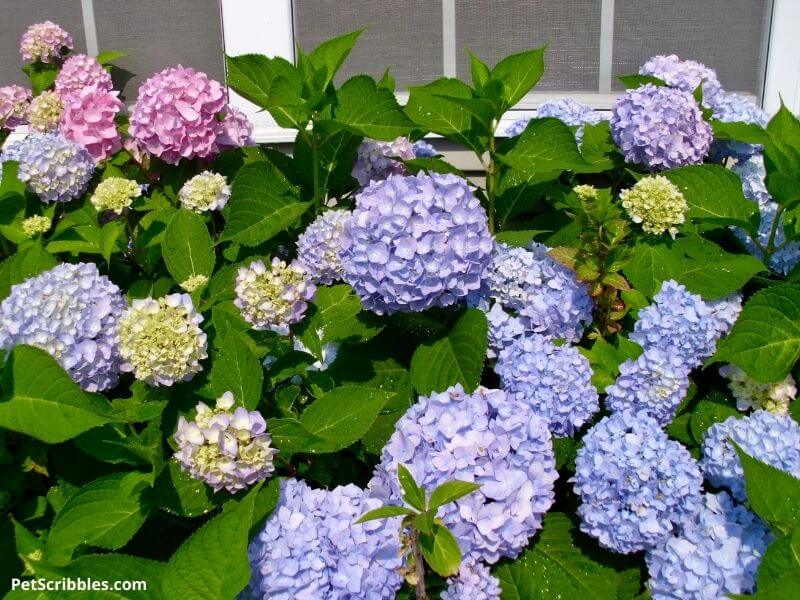

When we redid our landscaping, we didn’t keep those hydrangeas — don’t ask me why as I’m shaking my head not understanding why myself.
Instead, I asked the landscapers for Pinky Winky hydrangeas (love them), Little Lime Hydrangeas (love them), bigleaf hydrangeas and two dwarf mophead hydrangeas (Pia hydrangeas).

The bigleaf hydrangeas arrived without a name, and I didn’t press the issue.
They were a pink rose color, almost identical to the Pia hydrangea color. I planned to change the color to blue using a soil acidifier.
Here’s the short version:
The bigleaf hydrangeas weren’t placed properly when first planted — my fault for thinking these particular landscapers knew more than I did.
So they quickly overtook their spots within a few years — even the dwarf ones.
Disclaimer: I’m a huge fan of true landscapers and landscape designers. Huge! I’m not a fan of landscapers who might say they know about plants but actually don’t. There’s a reason some landscapers are much cheaper than others. Do your research and get references.

The image above is the newly planted foundation garden (2014). Here’s what you see:
1 = Silver King Euonymus shrubs, which will form a hedge underneath our windows
2 = large unnamed mophead hydrangeas planted in between the hedge and an ornamental tree
3 = an ornamental maple tree
4 = Pia dwarf hydrangeas planted just in front of an ornamental tree
In addition to these bigleaf hydrangeas needing to be transplanted due to the overcrowding, they also were suffering from black spot.
Look at the overcrowding at the back of this bed, below:

These dwarf hydrangeas were fighting with the ornamental maple tree for space:
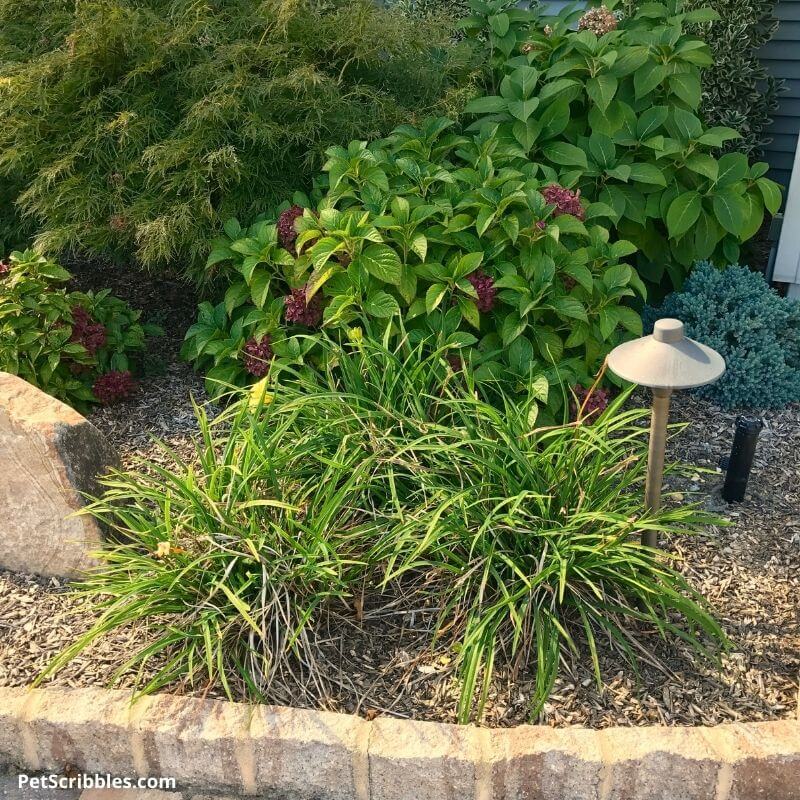
After a few years, we transplanted the five hydrangeas into our back yard garden and hoped for the best.

Are black spots on hydrangeas bad?
There are two diseases that can infect hydrangeas and cause these black spots.
Dumbing it down for myself — and for you — here is the bare minimum you need to know.
First, there are several reasons we see black spots on hydrangea leaves:
- not enough air circulation between plants
- branches/stems too close together, especially near the base of the plant
- humidity
- overhead sprinklers
- lots of rain

Second, these “black spots” on the leaves of hydrangeas are primarily caused by wet and/or humid conditions.
The two diseases responsible are:
- Cercospora Leaf Spot (pronounced CIRCUS-SPORA)
- Anthracnose (pronounced AN-THRAK-NOES)
Yes, these black spots are bad, but there are remedies to get rid of them.
Next, a bit of background on these two diseases.
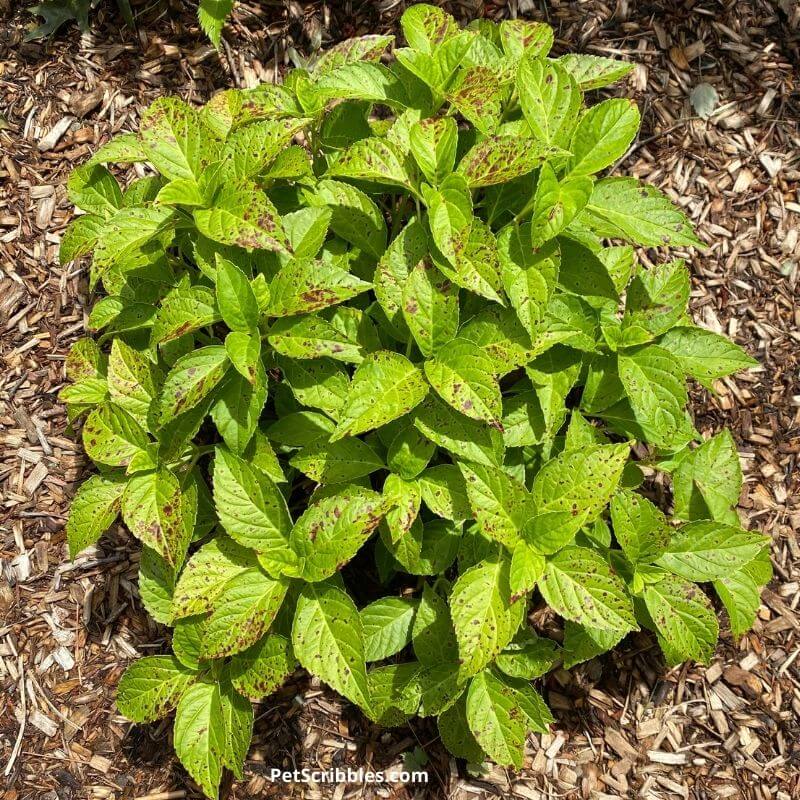
Cercospora Leaf Spot
Cercospora Leaf Spot happens when hydrangea leaves stay wet from either sprinklers or rain.
This won’t kill your hydrangeas but obviously the leaves look horrible and most likely will fall off the shrub.
Your hydrangeas infected with this may have less flower buds (and flowers) during the blooming season too.
Cercospora may begin in one part of the shrub and spread to other parts.
Anthracnose
This disease is a fungus due to hot, humid weather.
The fungus attacks the leaves and flowers of hydrangeas, making the familiar looking black spots, and it happens all over the shrub at the same time, versus starting in one spot.
Anthracnose can stick around in your garden debris during the Winter, so you may have to treat your hydrangeas the following season.
How do I know which disease my hydrangeas have?
Both diseases mentioned above have slight differences in what the “black spots” look like on the leaves.
Since both diseases are treated the same way — by using a copper fungicide — it’s more important to know how to treat the diseases versus which type of disease your hydrangeas have.
At least that’s my opinion.
I’m sure there will be experts who may disagree, but as a home gardener I think it’s more important to know some general information and most important to know how to treat problems that crop up.
Helpful tip: There are plenty of images you can find doing a simple internet search showing examples of both diseases. In my opinion, I don’t think it’s crucial to know which one your hydrangeas have. Why? Because both are caused by wet and/or humid conditions and because the treatment solution is the same for both diseases.
Whether it is Cercospora or Anthracnose, the remedy is to treat the hydrangeas with a copper fungicide, usually in a spray form.
I use Espoma Copper Soap, which you spray on the leaves.
No matter which type of copper fungicide you use, follow package directions and know that you will have to stay on top of it!
Preventative measures to avoid getting black spots
There are several preventative measures you can take to help prevent black spot from taking over your hydrangeas.
First, thin out the stems your hydrangeas in early Spring, removing the oldest stems.
Don’t remove more than 1/3 of the stems.
You can also remove stems just after flowering.
This will increase air flow, helping leaves dry out easily.
Second, don’t over-fertilize your hydrangeas, as too much fertilizer can make them more susceptible to diseases.
Use a slow-release organic fertilizer such as Espoma Holly-tone, rather than chemical-based fertilizers.
Third, try to avoid using overhead sprinkler systems with your hydrangeas.
Water them at the base of the plant, using a garden hose or drip hoses.
If you have a sprinkler system, run it on sunny days in the morning so the sun has time to dry the water off the leaves during the day.
Fourth, make sure to throw away any diseased leaves, stems, flowers that you remove from your hydrangeas.
Don’t add them to your compost pile.
In late Fall, clean up any fallen leaves and debris surrounding your hydrangeas.
How to treat black spots on hydrangeas
So let’s say that — your hydrangeas have black spots.
Don’t fret too much, but do get out there and try these remedies:
Remove infected leaves.
If you have just a handful of infected leaves, snip them off.
If you have many infected leaves, you still need to remove them. It will take longer and may result in removing stems as well.
Remove the oldest stems for air circulation.
As mentioned earlier, removing stems will increase air flow and help leaves to dry out better.
It’s best to make this a regular part of your early Spring pruning, however you can also do this just after your hydrangeas have flowered.
Make sure not to remove more than 1/3 of the stems.
Use a fungicide.
Treat the infected areas with a fungicide spray such as Copper Soap.
If you catch the infections early, then spraying can help eliminate the problem, along with removing infected leaves and creating more air flow among stems.
I got rid of my bigleaf, mophead hydrangeas!
This may sound extreme, but digging up and removing our mophead hydrangeas was indeed the last resort for me.
And one that I don’t regret. Here’s why.
Although they started out fantastic every year . . .

. . . they always ended up like this:

First, I spent the past three years constantly spraying them for black spot.
I did all of the steps I mentioned above, but the second problem we faced is these hydrangeas need SO MUCH WATER all the time or they wilted.
And I’m not talking about the slight wilting that occurs daily when the full sun hits overhead.
We did an experiment, and watering at the base of the plant for long periods of time — much longer than our usual sprinklers run — was the only thing that worked.
It was way too much water to use just to keep these looking pretty.
So, after three years of spraying them for black spot, trimming out the oldest stems, only watering from the base of the hydrangeas, plus their relentless need for water — I’d had enough.
It was time to say goodbye.
This year, I replaced them with panicle hydrangeas — specifically two Little Quick Fire hydrangeas, which so far early in the season look adorable!


Are panicle hydrangeas better resistant to black spot?
Panicle hydrangeas are the hardiest of all hydrangeas species, so they are the easiest to grow and the most adaptable to different garden conditions.
Panicle hydrangeas do great in hot and humid weather, and they also can survive Northern Winters. They are much stronger than mophead hydrangeas!
And for me?
I much prefer enjoying hydrangeas that are happy in my gardens versus fighting with hydrangeas that are miserable.
Miserable plants make for a miserable gardener. And we don’t want that!
Video showing what happened
Below is a video showing you exactly what happened to our mophead hydrangeas — including the not-so-lovely black spots on hydrangeas — and how the newly planted Little Quick Fire hydrangeas are doing so far.
Gardening shouldn’t be frustrating!
So there you have it.
I tried.
I did everything suggested to treat black spots on hydrangea leaves. But eventually I realized it was just too much work.
All of us garden because we enjoy it, right?
We love flowers, we love to nurture plants, and we love to care for our gardens.
Whether you have a little garden plot or several garden beds, remember that gardening should be soothing, fun, and satisfying.
Your case may be different, and I hope that the above solutions help you!
Happy gardening!
Learn more about my favorite hydrangeas!
Below are links to my articles on hydrangeas that I love!
(And I still love Pia hydrangeas, even though they weren’t happy in my gardens.)
Pia Hydrangea: A Pink Dwarf Hydrangea You’ll Love!

Little Lime Hydrangea — Your Ultimate Guide
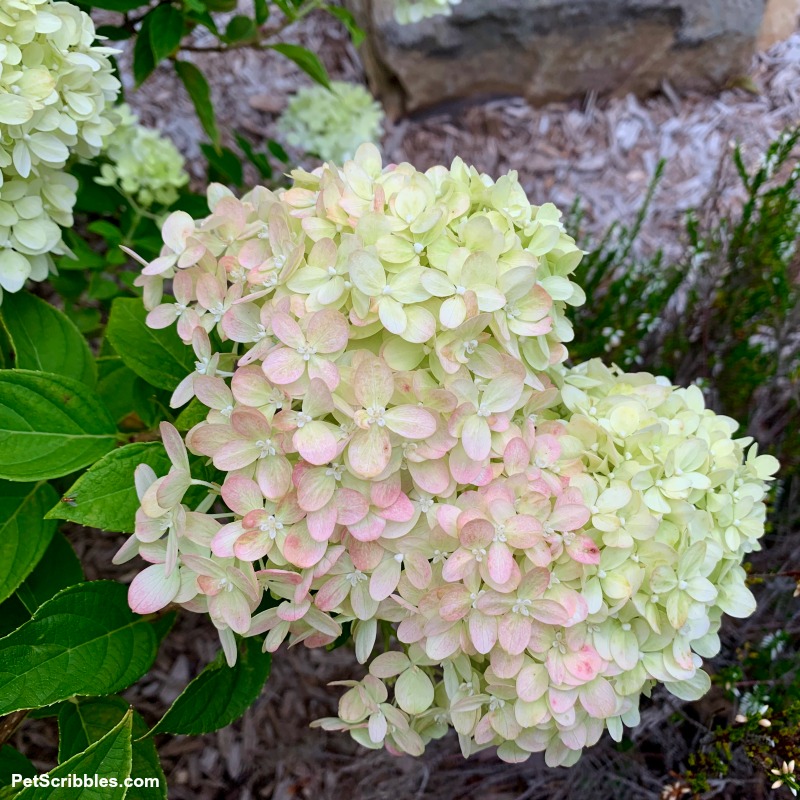
Pinky Winky Hydrangea Care — Your Ultimate Guide


I’ve been waiting for a video like this for two years. Thank you, Thank you.
Two years ago, my plants were infested with the fungus. It was so ugly. I cried about it and was embarrassed because of them. I didn’t want anyone to see them. That’s how ugly they were! I believe it was August and I said to my husband they have to be taken out NOW! I can’t look at them. So instead he cut them all the way down to the bottom. Next year they came up but no flowers and they did start with the spots later on. I kept spraying them and that was that. It did not take care of it. This year they came up with beautiful leaves and produced multiple flowers, no spots yet. I’m waiting, and if they do, they will definitely be taken out. When this happened I couldn’t find out much information about it. I even went to a nursery and believe or not they were not too helpful. Do you believe it. Anyway, with a lot of research I found out about the black spots that the leaves were getting water on the leaves, etc. You are the first gardener that gave an excellent video in plain English about this situation. Thank you so much! I do have a question. I haven’t sprayed them yet. Should I spray without the spots? I know it’s only July and I’m sure it’s going to happen. I’m a pessimist, ha, ha. Just want to know what you think. Also I live in southern New Jersey. Hope this comment wasn’t too long. Thanks!
Hi Irene — your comment wasn’t too long at all! You sound exactly like me last year! I was embarrassed and tried to only take pictures of the garden without including the horrible-looking hydrangeas. And when they grow big, you can’t help but see them anyway. Yuck! Maybe spraying them preventatively will work. I didn’t try that, and I probably should have. So I’d say go for it, as it can’t hurt and may in fact solve the issue. I’m crossing my fingers for you because it is horribly sad when they go from beautiful flowers and lush leaves to icky, sickly looking shrubs. Let me know if the preventative spraying helps! And let’s hope we don’t get any more tropical storms here in southern NJ (like Elsa last night) this Summer!
Most informative article I’ve read! Every year I tell my hydrangea this is the last chance you have to survive without the leaf spot. I’ve been saying it for four years, and end up with leaf spot without fail around October. I think it’s time for a funeral. My question is if I should remove the plant now or wait until spring.
Thanks so much Gerry! Glad I could help you realize life is too short for the annual disappointment of black spot! I removed ours in the Fall — no need to have them stay in your garden any longer! This way, you’ll get to “see” how much room you have to put something else there — something that will love you back! 🙂 Plus, it just feels good to throw them away — like you finally have control over them!
My snowball hydrangea was new last year. In spite of ground watering only, it ended up with terrible black spots. I will try the copper spay and heavier pruning, but if it is as bad as before, it will have to go. Question: if the fungus comes up from the soil (so I read) can I replant a different, less suseptible hydrangea in the same place?
Hi Merilyn, and I’m sorry to read your snowball hydrangea had a lot of black spot. Good idea to try the copper spray and see how that works for you this season. As for your question about replacing with another hydrangea — yes, that’s exactly what I did. I replaced my mophead hydrangeas with panicle hydrangeas which are a much hardier variety and had no black spot problems at all! I replaced mine with Little Quick Fire, but any of the panicle hydrangeas would work — just pay attention to the eventual mature size, so you plant something that won’t outgrow the space. I hope this helps! Keep me posted!
Thank you for your information and video! My hydrangeas were doing great and overnight they got black spots and leaves were dropping. I was beside myself. After finding your blog and video I’m not even going to try to save them. My question is do I have to worry about this disease affecting my other plants that are near them?
Hi Chris, No worries the black spot will get on your other plants — unless they are more mophead hydrangeas. We removed ours, and planted Little Quick Fires in their place. These panicle hydrangeas are doing wonderfully well, with NO black spot or any discoloration on the leaves and gorgeous flowers. (I’ve got a video on my YouTube channel where you can see what they look like.) I say go for it! And please let me know what you decide to plant instead!
Hi. I am currently going through this. This year is the worst it’s ever been. Yesterday I cut the five ft shrubs down to 3 ft. Salvaged all the bluish purple blooms, removed the leaves from the stems and place them in a vase. The flowers are beautiful. As I read your blog, I see I have to get back out there today and remove all the leaves and do more pruning. Purchase some copper soap and hope for the best next year. However, I think if it happens again, I will dig one of them out. I think it has outgrown the area it’s in anyway. But damn they are beautiful when in full bloom with green leaves. Thank you for your information. Ugh.
Oh Adria, I feel your happiness with the beautiful flowers yet sadness and frustration with the black spot. It can be SO very frustrating. I get it. Perhaps if you decide to remove one and keep the other, you will be able to keep the black spot in check with ongoing spraying with copper soap. I personally wasn’t able to, but it IS possible. So I wish you luck and better weather to decrease the chances of black spot next year! And in the meantime: enjoy those wonderful flowers in the vase!
Hello! Thank you for the article. I read this a few months ago to identify the black spots on my hydrangeas. I love them so. I have several of them and I just couldn’t get enough and I added 3 more. They came with spots on them from the nursery. I didn’t know what it was. Now all 9 plants have them. I spent the summer spraying and the leaves just kept coming with spots. So by October I said that’s it they are coming out. But it felt too late to plant something. I’m counting the days until I can plant something else. I’m so embarrassed and sad. They look horrible! They really fit in with Halloween but now that it’s January it’s just depressing. Should I rip out now or just do wait? I don’t even know what to plant. I’m in NE Florida and they are still flowering and taunting me.
Hi Deb — First of all, you have my sympathy because I totally understand how you’re feeling! Don’t be embarrassed — part of gardening is learning what works best for our individual gardens! But I completely can relate to feeling like the shrubs are taunting you — I get it! I’m not familiar with nursery schedules — i.e. when garden nurseries sell hydrangeas and other flowering shrubs in Northeast Florida, so I’m unsure how quickly you can purchase something to replace the evil shrubs. I see on the Proven Winners website — as just one mail-order example — that they will ship plants to your area in early- to mid-April. Knowing it will still be a few months, perhaps you want to cut them back a bit, so that the black spot isn’t so obvious to you. Maybe turn them into low growing leafy shrubs for the time being until it’s time to plant something new.
Another option is to dig them out now, and clean up the area of any black spot leaves, fill in the holes — or just cover them so nobody accidentally falls into them.
As for something to replace them with… Panicle hydrangeas to fabulous in heat and humidity! Here in southern New Jersey, our Summers are horribly hot and humid, and the panicle hydrangeas I have don’t get any black spot and bloom wonderfully. They are easy-care and some varieties can also stand up VERY well to any heavy storms too. (Just don’t consider Limelight hydrangeas, as the floppiness factor drives gardeners nuts — it’s almost an art form to prune the stems to keep them from drooping.)
Hi Deb, My endless summer hydrangeas developed a fungus. They started out great in may/June but by July, it was a horror. . I had same problem last year and pulled the plants and put in new ones. But sadly I got the fungus again! So disheartening. Two questions: are these dead forever or if I cut them back, is there a chance they will rebloom next spring? If I do pull them, do I need to replace all the soil for a future replanting? Thanks in advance.
Hi Shelley — Laura here from Garden Sanity, although I know you directed your question to Deb. If the fungus — whichever one you might have that causes black spot — is in the soil, then planting the same plants will result in them also getting the fungus. It’s frustrating but that’s what happens. If you cut them back now, you may in fact be removing the flower buds for the following year which are developing already. Endless Summer blooms both on old and new wood. So even if you remove the buds from the older wood, you will still get some flowers next year from the new stems. As for replacing the soil, you can do that, but an easier method will be to plant something else instead of more mophead hydrangeas. I had Endless Summer and loved them, so I realize this is a bittersweet decision. I swear by panicle hydrangeas because they are much hardier and a lot less fussy. I replaced my mopheads with Little Quick Fire panicle hydrangeas, which haven’t had any black spot at all, and I did not replace the soil before planting them. I hope this helps!
Hi there! So happy I found this post. Last summer I started noticing black spots on all three of my beautiful huge endless summer plants. The previous owner of my home planted them many years ago. I tried to cut as many leaves as I could but didn’t treat the plants.
Fast forward to now and the new buds have been starting to emerge over the last couple of weeks but I’m noticing that the center of many of the buds is black and dried out. Many have fallen out on their own. I remember in previous early springs I’d see the tiny little green clusters in the middle of the buds which would eventually grow into the flowers – but now I only see these dried out black centers in many of the buds. Have you ever seen this before? Could it be frost damage? I’ve looked at neighbor’s hydrangeas and they don’t see to have this. Any insight you have would be so appreciated – sick plants can be so distressing! Thanks so much!
Hi Amanda, I’m so sorry your Endless Summer buds are black. Yes, that’s from freezing or frost damage. And I understand your frustration that you don’t see that on your neighbor’s hydrangeas. Even if your neighbors have the same exact Endless Summer hydrangea variety, every yard and garden has different micro-climates, meaning it can be warmer or colder temperature-wise in the same yard. One spot can get more wind, another spot is more sheltered and stays warmer. And it’s hard to predict from year to year — it all depends on the weather even in the Winter. For now, all you can do is wait and see what happens. The good news — and yes there’s good news — is that Endless Summer bloom both on old and new wood, so you should still get some blooms this year. I’ve switched to panicle hydrangeas because they are much more Winter hardy than the mophead hydrangeas for me. (Panicle hydrangeas are Limelight, Little Lime, Fire Light, and so on.) I hope this helps?
Yes thank you so much! I actually dragged a landscaper who had been working on my neighbor’s yard to take a look and he also said it’s from the crazy dips in temperature this spring. Relieved to know it’s not something that needs to be treated. Fingers crossed they end up okay!
I don’t blame you dragging a landscaper over to take a look, Amanda! Mother Nature doesn’t always play nicely with our gardens. You should get some blooms off of the “new wood” flower buds that are and will be forming. Fingers crossed for you! Keep me posted!
Hello. I just finished watching your video and I wanted to say thank you so very much! I have had this issue with my beautiful mop head hydrangea. The first year it was gorgeous! It grew huge and had tons of flowers. But the next year the same thing happened to me. And we sprayed it with copper fungicide. It has happened for the last two years and we have sprayed. This year actually tomorrow, I’m pulling the damn thing out lol. We also had another hydrangea plant that I don’t know the name of. It wasn’t a mop head. I think it was a panicle. It had beautiful white flowers on it, but when it rains, the flowers all bend down to the ground. It looks bad. They never stay up. I ended up pulling that plant and plant in another area in my yard, but the deer ate it. My neighbor has some that look similar but they’re more of a sturdier bush. Is there any way you would know which kind I am talking about? Thank you for any help.
Hi Colleen — First of all, congrats on ridding yourself of a shrub that doesn’t make you happy! LOL Although I loved my mophead hydrangeas, they didn’t love me back and I felt such relief after removing them. I think you may have a panicle hydrangea called a Limelight, which is known for flopping badly after rainstorms. One of the reasons they flop is their stems haven’t developed into sturdy strong stems just yet. It takes several years for those stems to mature enough to keep the flowers upright. Having said that, those flowers get SO heavy when it rains. I have a 3-part video series on what happens to the flowers on my Limelight Hydrangea Tree after it rains and what you can do. And this advice can apply to Limelight Hydrangea shrubs as well. (You can find those videos also on my YouTube channel.) As for your neighbor’s similar-looking hydrangeas — she may have what I have myself: Little Lime Hydrangeas. They are smaller — getting 5 feet tall at maturity — but MUCH sturdier even with pruning them every year in early Spring. Check out my YouTube channel — go to the Hydrangeas playlist, and look at a few of my Limelight-related videos. I’ve got a Limelight Hydrangea Garden video that will show you what they look like in detail (from 2021) and two videos from this year (2022) that also will show you what these look like in detail: Mid-July Summer Garden Tour, and also Mid Summer Garden Tour (Front Yard). You can use the Chapter links in the description of each video to go directly to the Little Lime sections of those videos. I hope all of this helps!
Thank you so much for your reply and how detailed you were. I will definitely check out your videos. I have to put something in place of the one I took out, so want to make an informed decision. Hubby was not happy trying to get it out (he had to use a rope and his truck!), so I must plant something that will last and look good. Thank you again!! Colleen
Our husbands are never happy when having to remove plants! Ask my poor husband — he had to use a pick axe last year to remove some Knock Out Rose bushes…and it wasn’t fun! Hang in there!
Hi Laura, I had the purple than brown spots, spray after spray, this year with the the worst they have ever been, now covered in white fungus, flowers turned brown because of the weather, cut it back and dehead them first time had to do this I don’t do this till spring, it be looks a sorry site , thinking of digging the whole thing up I think this battle is lost , can I plant a hydrangea in the same place.
Hi Helen — I would dig them up, definitely! Time for something with MUCH less work required on your part! I planted Panicle Hydrangeas in the place of my mophead hydrangeas. They are hardier, don’t need any fussing over, and don’t suffer from black spot or fungus, etc. So that’s the variety of hydrangea I recommend to plant. There are so many lovely ones to choose from! If you watch my most recent September Garden Tour video on my Garden Sanity YouTube channel, I show five different varieties that I have in my front yard. (I have more in my back yard too!) I hope this helps!
Hi Laura, thank you so much for this post and explaining it simply for us who are newbies! We live on Nantucket year round and just bought a house that has beautiful mophead hydrangeas! A garden that we non-gardeners could actually be proud of. Yet it’s September now and they now look like burnt out flowers and brown spots on the leaves!!! (Crying now!) The hydrangeas surround our house, on one side they seem to be fine but the other is bad. We don’t know where to start. Do we just got off everything? The brown flowers and leaves? Or do I go get the copper spray and spray the leaves? I would think we just cut off the leaves and leave the flowers to just dry out and die? We really have no idea and don’t want to hire a pricey landscaper when we could do it ourselves. Pls help! I would like to save them if we can! It’s a very beautiful “mature” garden.
Hi Jeannie — First off, congratulations on your new home! I adore Nantucket, and we spent our honeymoon there years ago and didn’t want to leave! It was in late October, so no tourists and just wonderful people so friendly and the weather was that wonderful New England Fall weather…with a Nor’Easter mixed in for dramatic effect! LOL Secondly — I’m in love with the picturesque mophead hydrangeas on Nantucket and throughout the New England coastal towns. That’s where I first fell in love with them when I lived in Boston. If these were my mopheads, I’d pick off the brown spotted leaves, and you’ll already feel better about the hydrangeas. Then spray them — the remaining leaves and stems, to hopefully take care of any remaining fungus. I even lightly spray on the ground below and around the hydrangeas on the soil, or mulch, or whatever type of groundcover/soil you have. I love to leave the flowers on for Winter interest. Yes, as the Winter goes on, they could blow off or become ragged looking, but you’ll usually get a few months of pretty dried flowers out of them. (I know you probably already know this having lived there and seen other hydrangeas in Winter.) There’s no need for a pricey landscaper, so yes you can do this yourself! I realize it’s early October already, and Fall is setting in, so it may be difficult to actually know the proper state of your hydrangeas. However, don’t cut them back, just leave them be. Since they are mature, it means they’ve been through all sorts of weather and fungus and bugs and so on. So next Spring, once they have leafed out, begin a preventative spray routine. I would start with Neem Oil — use something like Bonide 3-in-1 — as a gentle preventative sprayed either early in the morning or in the evening after pollinators have gone to sleep (or haven’t woken up yet.) See how that does. The black and brown spots happen when we get super hot and humid weather — the humidity is the worst contributor to this problem. So my guess is these hydrangeas looked gorgeous for most of the Summer, and then developed the spots. (Although you may know best, if you were familiar with the house before you moved in.) I hope this helps, as it sounds like you inherited a wonderful garden! And no, I’m not jealous. Ok, slightly. Maybe more than slightly! LOL
Hi Laura,
Thanks so much for your reply. Yes Nantucket this time of year is beautiful. Nantucket is an amazing place to honeymoon! It’s really different vacationing here and living here but still it’s magical. There are days I still pinch myself that we live here! Personally, October is my favorite month (could be my bday month) LOL
Thank you so much for these tips! I will certainly implement once spring comes. My only question, there are ALOT of brown leaves now! Do I just cut them all off or just as much as I can or leave them at this point? We only just moved into the house in June so it’s our first year with the hydrangeas. My in laws have hydrangeas at their house but they have the ones with white flowers? They have the mop heads too but they had a landscaper so not sure if I ever saw brown leaves on them.
Appreciate the time you’re taking to answer!
You’re welcome Jeannie — and I’d pinch myself too if I lived there year-round! At this point, I’d let the brown leaves die off the shrub and fall to the ground. Then you can clean them all up for the season. There are so many different varieties of mophead hydrangeas, that it’s possible the variety your in-laws have plus where it is sited in their landscape just makes them not have as many brown leaves. Plus…a landscaper helps too, but I think that’s cheating. LOL You can also just take the brown leaves off of the “front-facing” parts of the shrubs — the parts that people see — if you want to somewhat hide the brown leaves. Up to you! Happy Fall!